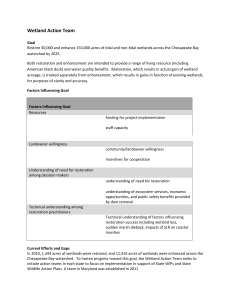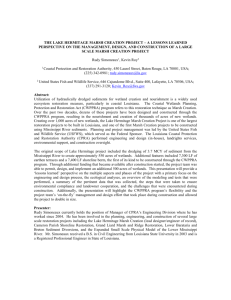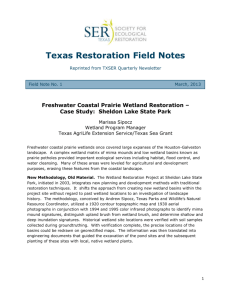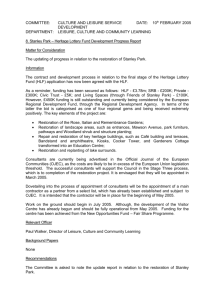Recent results from macroeconomic, water quality and hydrologic
advertisement
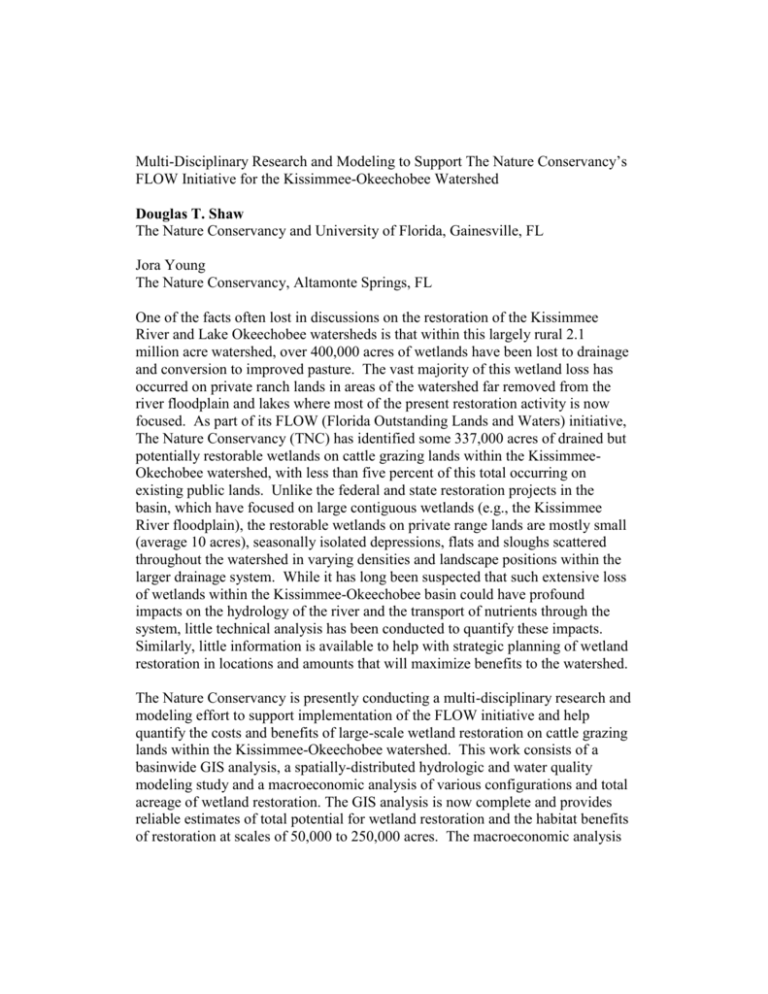
Multi-Disciplinary Research and Modeling to Support The Nature Conservancy’s FLOW Initiative for the Kissimmee-Okeechobee Watershed Douglas T. Shaw The Nature Conservancy and University of Florida, Gainesville, FL Jora Young The Nature Conservancy, Altamonte Springs, FL One of the facts often lost in discussions on the restoration of the Kissimmee River and Lake Okeechobee watersheds is that within this largely rural 2.1 million acre watershed, over 400,000 acres of wetlands have been lost to drainage and conversion to improved pasture. The vast majority of this wetland loss has occurred on private ranch lands in areas of the watershed far removed from the river floodplain and lakes where most of the present restoration activity is now focused. As part of its FLOW (Florida Outstanding Lands and Waters) initiative, The Nature Conservancy (TNC) has identified some 337,000 acres of drained but potentially restorable wetlands on cattle grazing lands within the KissimmeeOkechobee watershed, with less than five percent of this total occurring on existing public lands. Unlike the federal and state restoration projects in the basin, which have focused on large contiguous wetlands (e.g., the Kissimmee River floodplain), the restorable wetlands on private range lands are mostly small (average 10 acres), seasonally isolated depressions, flats and sloughs scattered throughout the watershed in varying densities and landscape positions within the larger drainage system. While it has long been suspected that such extensive loss of wetlands within the Kissimmee-Okeechobee basin could have profound impacts on the hydrology of the river and the transport of nutrients through the system, little technical analysis has been conducted to quantify these impacts. Similarly, little information is available to help with strategic planning of wetland restoration in locations and amounts that will maximize benefits to the watershed. The Nature Conservancy is presently conducting a multi-disciplinary research and modeling effort to support implementation of the FLOW initiative and help quantify the costs and benefits of large-scale wetland restoration on cattle grazing lands within the Kissimmee-Okeechobee watershed. This work consists of a basinwide GIS analysis, a spatially-distributed hydrologic and water quality modeling study and a macroeconomic analysis of various configurations and total acreage of wetland restoration. The GIS analysis is now complete and provides reliable estimates of total potential for wetland restoration and the habitat benefits of restoration at scales of 50,000 to 250,000 acres. The macroeconomic analysis was completed by Hazen and Sawyer, Inc. in December 2002 and compares full costs (including costs of restoration and acquisition of easements) and benefits (phosphorus removal, water supply, habitat improvement, revenue generated) with ten other phosphorus control options and strategies that have been proposed by the South Florida Water Management District for restoring Lake Okeechobee. A strategy of wetland restoration on 100,000 acres of improved pasture and rangeland ranked third among the alternatives in terms of total phosphorus removed and fifth among alternatives for total cost-effectiveness. The hydrologic modeling study, conducted jointly with the University of Florida, is still in progress and has initially focused on potential for wetland restoration in the Fisheating Creek (FEC) basin. The modeling approach uses GIS-based spatial information to quantify important hydrologic, topographic, soil and land cover parameters and spatially-distributed modeling of water storage, hydrologic fluxes and flow processes using the MikeSHE/Mike11 software developed by DHI, Inc. Rainfall response functions have been defined for four categories of wetlands common within the FEC basin as a means of determining the impacts of wetland restoration on seasonal runoff volumes and phosphorus loading. The model study is evaluating the relative benefits of different spatial configurations of wetland restoration in the basin, including restoration in headwaters versus downstream locations, clustering restoration on adjacent properties versus restoration widely distributed through the watershed and restoration of riparian or near-stream wetlands versus restoration of wetlands further removed from stream corridors. The results of this modeling will provide strategic direction to TNC for implementing its FLOW initiative and to government agencies involved in planning restoration and prioritizing funds for restoration and easement acquisition. Douglas T. Shaw, Ph.D. Senior Conservation Hydrologist The Nature Conservancy C/o University of Florida Department of Environmental Engineering Sciences P.O. Box 116450 Gainesville, FL 32611-6450 Ph: (352) 392-4209 FAX: (352) 392-3076 e-mail: dshaw@tnc.org

